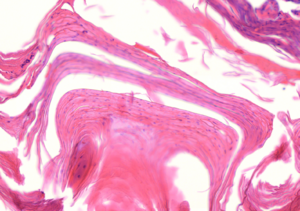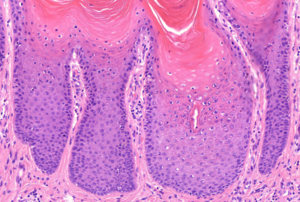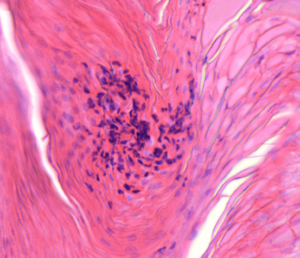48. Psoriasis: Difference between revisions
(Created page with "'''Staining''': HE '''Organ''': Skin '''Description''': Many changes are characteristic for psoriasis: Hyperkeratosis, which refers to increased thickness of the stratum corneum. Parakeratosis is the phenomenon where the cell of the stratum corneum have nuclei (they usually lose their nuclei). Neutrophilic microabscesses are focal accumulation of neutrophil remnants in the stratum corneum. (don’t mix these with parakeratosis) The epidermis has lost its stratum g...") |
No edit summary |
||
| Line 1: | Line 1: | ||
'''Staining''': HE | [[File:Psoriasis - overview.png|thumb|Overview|382x382px]]'''Staining''': HE | ||
'''Organ''': Skin | '''Organ''': Skin | ||
| Line 9: | Line 9: | ||
Hyperkeratosis, which refers to increased thickness of the stratum corneum. | Hyperkeratosis, which refers to increased thickness of the stratum corneum. | ||
Parakeratosis is the phenomenon where the cell of the stratum corneum have nuclei (they usually lose their nuclei). | Parakeratosis is the phenomenon where the cell of the stratum corneum have nuclei (they usually lose their nuclei).[[File:Psoriasis - microabscesses.png|thumb|Neutrophilic microabscesses and elongated dermal papillae|383x383px]]Neutrophilic microabscesses are focal accumulation of neutrophil remnants in the stratum corneum. (don’t mix these with parakeratosis) | ||
Neutrophilic microabscesses are focal accumulation of neutrophil remnants in the stratum corneum. (don’t mix these with parakeratosis) | |||
The epidermis has lost its stratum granulosum. | The epidermis has lost its stratum granulosum. | ||
| Line 21: | Line 19: | ||
Lymphoplasmocytic inflammatory foci are present in the dermis. | Lymphoplasmocytic inflammatory foci are present in the dermis. | ||
'''Diagnosis''': Psoriasis | '''Diagnosis''': Psoriasis[[File:Psoriasis - focal lymphocytic infiltrates.png|thumb|Focal lymphocytic infiltrates|338x338px]]'''Risk factors:''' | ||
'''Risk factors:''' | |||
* Mechanical irritation | * Mechanical irritation | ||
| Line 32: | Line 28: | ||
Psoriasis can be diagnosed clinically by the ''Auspitz sign''. When the scaly plaques are scraped off small pinpoint bleedings will appear underneath. This is because of the elongated dermal papillae. When the scale is ripped of the thin epidermis above the dermal papillae is ripped off too, which damages the arteries of the dermal papillae, causing these pinpoint bleedings. | Psoriasis can be diagnosed clinically by the ''Auspitz sign''. When the scaly plaques are scraped off small pinpoint bleedings will appear underneath. This is because of the elongated dermal papillae. When the scale is ripped of the thin epidermis above the dermal papillae is ripped off too, which damages the arteries of the dermal papillae, causing these pinpoint bleedings. | ||
[[File:Psoriasis - parakeratosis.png|thumb|Parakeratosis|left]] | |||
[[File:Psoriasis - loss.png|thumb|Loss of stratum granulosum (don’t ask me how we can see that)]] | |||
[[File:Psoriasis - neutrophilic microabscess.png|thumb|Neutrophilic microabscess|left]] | |||
[[File:Psoriasis - parakeratosis.png | |||
[[File:Psoriasis - loss.png | |||
[[File:Psoriasis - neutrophilic microabscess.png | |||
[[Category:Pathology 2 - Histopathology slides]] | [[Category:Pathology 2 - Histopathology slides]] | ||
Latest revision as of 14:55, 7 July 2024
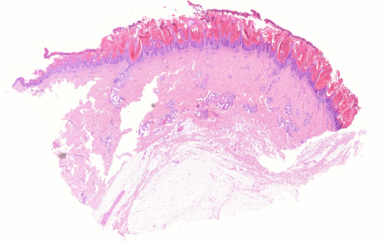
Staining: HE
Organ: Skin
Description:
Many changes are characteristic for psoriasis:
Hyperkeratosis, which refers to increased thickness of the stratum corneum.
Parakeratosis is the phenomenon where the cell of the stratum corneum have nuclei (they usually lose their nuclei).
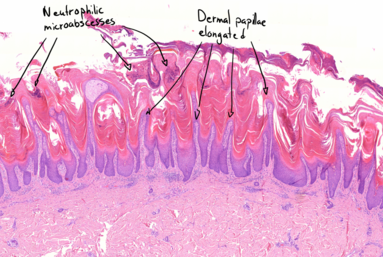
Neutrophilic microabscesses are focal accumulation of neutrophil remnants in the stratum corneum. (don’t mix these with parakeratosis)
The epidermis has lost its stratum granulosum.
There is acanthosis, which refers to increased thickness of the epidermis. It is equal to epidermal hyperplasia.
The dermal papillae are elongated and penetrate long into the epidermis.
Lymphoplasmocytic inflammatory foci are present in the dermis.
Diagnosis: Psoriasis
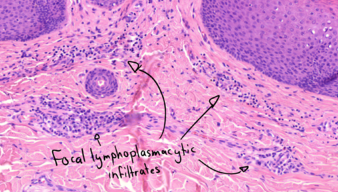
Risk factors:
- Mechanical irritation
- Genetic predisposition
- Bacterial upper respiratory tract infection
Theory:
Psoriasis can be diagnosed clinically by the Auspitz sign. When the scaly plaques are scraped off small pinpoint bleedings will appear underneath. This is because of the elongated dermal papillae. When the scale is ripped of the thin epidermis above the dermal papillae is ripped off too, which damages the arteries of the dermal papillae, causing these pinpoint bleedings.
